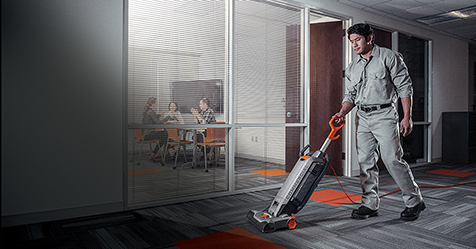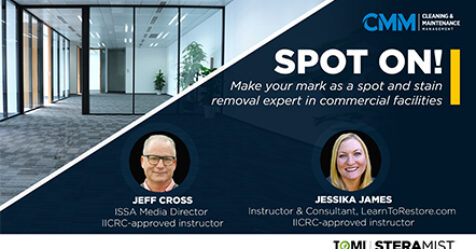Looking back, it’s often quite surprising how so many of those classes we took in school have proved valuable later in life. For example, those of us in the cleaning industry are finding that a good, overall background in chemistry is becoming essential to our work. This is because of all the chemicals used in cleaning and the need to know which chemicals work best in what situations — and why.
Carpet chemistry 101
This need for product/market knowledge is especially true in carpet cleaning. While the actual ingredients included in a carpet cleaning solution are important, understanding the pH of the product and what it means can be even more critical. In fact, knowledge of pH is essential to carpet cleaning technicians, allowing them to select the best product for the types of stains and cleaning problems they encounter.
What is pH?
For our understanding in the professional cleaning industry, pH is used to refer to the relative acidity or alkalinity of a water-based solution. There is a range from 0 to 14 to indicate the pH level of a product. Acids have a pH of 0 to 7, with 0 being the most acidic and 7 being neutral, which is neither acidic nor alkaline. A reading above 7 and the products become increasingly alkaline.
Additionally, for each point or number the pH moves in either direction away from 7, it increases by 10 times the previous number. For instance, a product with a pH of 12 is 10 times more alkaline than a product with a pH of 11; conversely, a solution with a pH of 4 is 10 times more acidic than one with a pH of 5.
The pH of carpet cleaning
When cleaning acidic soils, which are the most common type of soils, it is recommended to use an alkaline detergent. And, to eliminate alkaline-type soils, use a cleaning solution on the acidic side of the scale, typically with a pH of 2 to 5.
According to the IICRC (Institute of Inspection, Cleaning and Restoration Certification), for general cleaning of carpet that is moderately-soiled and made from synthetic fibers, such as those in a residential setting, an alkaline cleaner with a pH around or under 10 might work best. However, carpet cleaning technicians working in a busy restaurant, for instance, where the carpet may be heavily-soiled may require a product with a higher alkaline pH concentration of 12 to clean a synthetic carpet. But, these technicians must ensure that using chemicals with this level of alkalinity does not void the carpet manufacturer’s warranty.
When cleaning carpet or fabrics made from natural sources, such as wool or cotton, a neutral or slightly alkaline chemical solution is often the best choice. This choice helps protect the fibers and the coloring.
Matching the task
Although alkaline cleaners are used most often in carpet cleaning, there are times when an acidic product is preferred. For example, if a carpet has been shampooed, bonnet cleaned or cleaned with a carpet extractor with an insufficient vacuum system, there may be considerable amounts of alkaline detergent left in the carpet. This can result in quick resoiling because the chemical residue acts as a magnet, drawing soil into the fibers. An acidic solution breaks down the alkaline residue so that it can be removed from the carpet. Many times, carpet cleaning technicians can avoid this problem by using an encapsulation system. This system uses crystal polymers found in encapsulation chemicals, which takes the oily soils and makes them dry so that ordinary vacuuming can remove them. It also helps resist resoiling, repels dry soils as well as protects carpets from oil-, water- and alcohol-based stains.
Evaluate the fiber
Before selecting a detergent with a specific pH level to clean carpet, technicians must know what type of carpet fiber they are working with. There are various tests that can be used, such as trimming a small amount of the fiber and burning it with a butane lighter in an ashtray, to determine what type of fiber the carpet is made of. Different carpet fibers will have different colors and embers when burning as well as different odors; a wool fiber, for example, will have an orange flame and an odor of burning hair. Additionally, the ash left behind after burning can be key in determining the type of carpet fiber.
Synthetic carpets leave a hard bead behind since they are made of plastic, while natural fibers leave behind a soft powdery ash. However, usually the easiest method of determining the type of carpet fiber — or at least what should be done first — is to simply ask the client or manufacturer. Today, 95 percent of all fibers used are synthetic — nylon, polyester or olefin — with nylon being the most common. With these fibers, a cleaner with a pH of no more than 10 is recommended and if the carpet is only lightly-soiled, a neutral cleaner may be effective and even safer to use.
Evaluate the soil
Once the type of fiber is known, technicians need to determine what type of soil is in the carpet and the amount of soil present. As mentioned earlier, most soils on carpets are acidic, consisting of food, beverages, bodily fluids, etc. — all requiring a neutral to alkaline cleaner for removal. Other common soils include sand, animal hair, paper and grass, which also can be removed with a neutral or alkaline cleaner. However, the first and best step is to vacuum with a high-quality cleaner to remove as much dry soil as possible before cleaning.
There are other considerations that can affect the pH level of the products used to clean carpet. The age of the carpet, color and dyes used, wear levels and whether a stain retardant has been applied are all things to think about. If available, the carpet manufacturer’s care and maintenance guide will advise what types of detergents and pH levels are not only recommended, but must be used to maintain the carpet’s warranty. Additionally, the IICRC offers certification courses that address many carpet cleaning issues, including pH.


